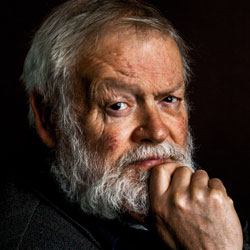An engineer, you would appreciate
The technique for yoking the mule-cart —
When they fasten a wicker basket on top
And take down from its peg a boxwood yoke
With knob and guide-hooks for holding the reins
And bring out the lashing-rope – fourteen feet long –
And settle the yoke on the well-polished pole
And slip the eye of the rope over a peg
And tie the rope three times around the knob
And secure it all the way down the pole
And twist if under a hook and thus yoke
Strong-footed draught-mules to the mule-cart.
(What’s the function of the peg exactly?)
Notes on the Poem
Last week's Poem of the Week had us thinking about the journey of the poet and their words to arrive at the page before us, the readers. This week, let's consider how the poet and the poem can send us from the page and down interesting paths. Michael Longley's "The Mule-Cart" from his 2015 Griffin Poetry Prize winning collection The Stairwell does just that. Longley inventories with apparent precision the surprisingly complex steps and components associated with yoking a mule-cart, acknowledging the presumed reader of the poem as someone technically inclined or educated. The rhythm of how he spools out these details is rather hypnotic and assuredly poetic. But wait. He doesn't acknowledge the living, breathing aspect of the operation until the end, after which the parenthetical question suddenly seems like an oversight ... and rather alarming. With concern, this reader departed the page to google a demonstration of the task the poem describes: This instructive video factors in the living creature from the outset. It's certainly not as sleek and polished a presentation as Longley's poem, but it's rather reassuring to see the people in the video riding off down the road happily and securely - the functions of all pegs et cetera accounted for - at the end. This reader returned to the page with renewed appreciation for what Longley was really itemizing here.
